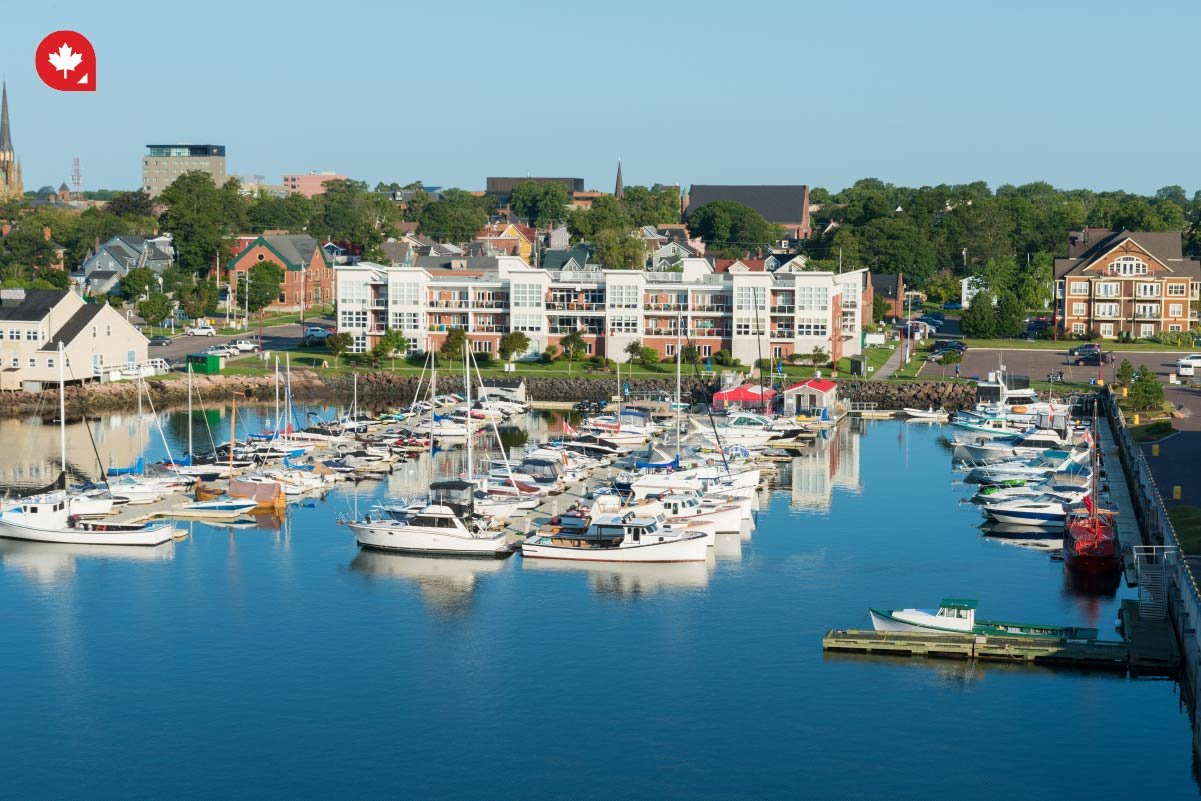The history of immigration to Charlottetown is linked to its origins as one of the earliest European colonial settlements on North America’s eastern seaboard. Consequently, the majority of Charlottetown’s immigrant population is primarily made of Scottish, Irish, Welsh and English citizens, according to Statistics Canada. Other significant European immigrant populations include French, German, and Dutch people. Curious about how you can obtain a place yourself among these numbers?
Establish yourself in claiming a spot as a permanent resident in Charlottetown by examining our city guide!
About Charlottetown

Dating back to the 1720s, Port la Joie, situated across the harbor of Charlottetown, was established by the French and was renamed after Queen Charlotte when the island was passed to Britain in 1763.
The city is well-renowned for its exceptional deep-water harbor and airport. It is the center of economic activities, driving tourism, governmental matters, fisheries, and agriculture in Prince Edward Island.
Charlottetown boasts plenty of historic buildings, such as the Government House and the Province House, the legislative body that usually hosts talks and plans around Canada's unification.
One of the safe havens in North America for early religious pilgrims, Charlottetown is dotted with towering religious architecture such as St. Paul's Anglican Church, St. Peter's (Anglican) Cathedral, and St. Duncan's Basilica church.
Where is Charlottetown on the Map?
Geographically positioned on the southern shore of Prince Edward Island, Charlottetown is the province's cultural and economic hub. Its location places it at the heart of Atlantic Canada's maritime beauty. Prince Edward Island is one of Canada’s three Maritime Provinces and consists of the main island and 231 smaller, mostly uninhabited islands.
The main island is located in the Gulf of St. Lawrence, 200 kilometers north of Halifax, Nova Scotia, and 600 kilometers east of Québec City. The island only has two significant urban areas; the capital city of Charlottetown and its suburbs, and the harbour of the Summer side. The rest of the island is rolling hills, sandy beaches, and woods.

Climate in Charlottetown
Embrace the seasons in Charlottetown, where the maritime climate offers a taste of everything. Charlottetown has a humid continental climate, according to the Koppen Classification. Summers in Charlottetown are comfortable and partly cloudy.
In contrast, the winters are freezing, snowy, windy, and mostly cloudy. The annual average temperatures in Charlottetown vary between 11°F (-11.67°C) to 74°F (23.33°C) and rarely ever go below 3°F(-19.44°C) or beyond 82°F (27.77°C) according to Weather-spark.
Charlottetown experiences rainfall throughout the year, with October being the month with the most rainfall averaging 3.4. The month with the least rainfall, February averages only 1.0 of rain. Charlottetown’s snow lasts for six months, from about early November to the beginning of May. In August, there is no snowfall in Charlottetown in Weather-spark.
Work and Jobs in Charlottetown
Charlottetown's economy thrives on diverse sectors like tourism, agriculture, and technology. Job opportunities abound, with a burgeoning entrepreneurial scene and a focus on sustainable industries.
Explore possibilities in healthcare, education, or the ever-expanding tech sector that contributes to the city's economic vitality. The unemployment rate in the city is 5.1% according to Statistics Canada, one of the lowest in the region and ensures that prospective foreign immigrants can secure permanent employment in the city.
Among the top jobs with similar pay that you can apply for in Charlottetown includes, with information from Canada’s Job Bank and National Occupational Classification (NOC) codes:
| Occupations in Charlottetown | Average Annual Salary | NOC Codes |
|---|---|---|
| Assistant Retail Manager | 79,295.58 | 60020 |
| Personal Banking Associate | 70,344.54 | 63102 |
| Addiction Counselor | 70,282.83 | 41301 |
| Virtual Nurse Practitioner | 68,956.67 | 31302 |
| Logistics Team Lead | 63,457.06 | 12013 |
| Media Sales Representative | 60,814.81 | 64101 |
| Rigger (Construction) | 46,250.64 | 75110 |
| Cleaning and Maintenance Supervisor | 44,937.15 | 62024 |
| Restaurant Evening Supervisor | 42,989.80 | 62020 |
| Delivery Driver | 40,974.37 | 75201 |
Cost of Living in Charlottetown

The cost of living in Charlottetown is lower than other major cities in Atlantic Canada such as Halifax. This is reflected in the lower apartment rent costs in Charlottetown for both single individuals and nuclear families (four people) compared to Halifax, according to Numbeo.com.
| Apartment Types | Cost in Charlottetown (CAD) | Cost in Halifax (CAD) |
|---|---|---|
| 1 Bedroom Apartment in the City Center | 1,261.25 | 1,888.94 |
| 1 Bedroom Apartment outside the City Center | 1,045.00 | 1,572.22 |
| 3 Bedroom Apartment in the City Center | 2,150.00 | 3,109.09 |
| 3 Bedroom Apartment outside the City Center | 1,806.25 | 2,562.05 |
Neighborhoods in Charlottetown
If you are looking to immigrate to Charlottetown, then you’d be pleased to know that there are several neighborhoods to explore in this city. We have listed some interesting neighborhoods below:
Sherwood
Located in Queens County, you can find this neighborhood in the heart of Charlottetown. The town was first known as Sherwood station, later renamed Sherwood in 1938. As an agricultural area, housing in this town can be fairly affordable, with single detached homes constructed throughout the town.
Brighton
If you're into Victorian homes with breathtaking views, this neighborhood, with its beautiful streetscapes, may be ideal. Not only can you enjoy its unique architecture and waterfront beach lighthouse, but this neighborhood also boasts friendly people and families.
Spring Park
Spring Park is a vibrant town that houses the popular Spring Park School, with the Spring Park Road stretching towards the rural farming area. Just outside the city, Spring Square is home to outdoor events such as circuses from the 1920s to the 1950s. This area may be ideal if you're looking for smaller, cozier homes central to cafes, schools, and malls.
Parkdale
This neighborhood is also situated near a wide range of hotel or resort options, allowing you more flexibility when it comes to a comfortable stay. In addition, you can enjoy Victorian-looking homes with a mix of mansions while walking within walking distance of the waterparks in Toronto.
Transportation in Charlottetown
Navigating the city is a breeze with Charlottetown's well-connected transportation system. Whether you prefer the convenience of public transit or the freedom of driving, the city offers accessible options.
Public Transit in Charlottetown
Charlottetown's public transit system, T3 Transit, offers daily municipal transit services to Charlottetown, Cornwall, Stratford, and Summerside. T3 Rural Transit provides island-wide transit on provincial highways, connecting communities such as Georgetown, Montague, Souris, St. Peter's, Summerside, Borden, O'Leary, Alberton, Tignish, and Charlottetown. Transit PEI is the Island Wide Rural Transit System, operating Monday to Friday on provincial highways.
Car and Ride Sharing in Charlottetown
Various car rental agencies, including AVIS, Budget, Enterprise, Hertz, National, and Thrifty, are available at the Charlottetown Airport (YYG). Turo is a car-sharing service connecting visitors who want to rent a vehicle from a local car owner. Kari is a locally-owned and operated ride-sharing service in Prince Edward Island.
Taxis, Shuttle, and Bike Rental Services in Charlottetown
Taxis usually charge based on the distance traveled and the number of individuals in the vehicle. Nellie's Landing E-Bike Tours & Rentals is a bike rental provider in the area.
Things to Do in Charlottetown
From the Confederation Centre of the Arts to the vibrant Victoria Row, Charlottetown is a haven for culture enthusiasts. The city is a treasure trove of experiences waiting to be uncovered.
Visit the Iconic St. Dunstan's Basilica in Charlottetown
This breathtaking structure was designed as a French Gothic church until it tragically burnt down. But the cathedral was raised from the ashes and rebuilt by Charlottetown, and today its iconic spires can be seen in the town's skyline.
Browse Through the Streets of Charlottetown in Victoria Row
Victoria Row is a great place to visit in Charlottetown. This quaint and historical street has various things to keep you happily occupied for hours, whether you are browsing the local shops, pursuing the indigenous art collections, or sampling the tasty local treats on offer.
Drop By and Visit the Confederation Centre of the Arts
The Confederation Centre of the Arts should be just one of the reasons to visit Charlottetown. The center is dedicated to showcasing visual and performing arts that are both contemporary and historical. Stretching over a block, the local art gallery has more than 150 exhibitions of traditional art forms, paints, sketches, prints, and more.
Enjoy the Sea Breeze at Peake's Wharf
Peakes Wharf is a historic waterfront key part of Charlottetown's founding. It was where the confederation's first fathers landed in 1864. Today, Peake's Wharf has over 20 shops along the waterfront, from clothing at the Misty Lighthouse Fashion to tasty lobster meals at MacKinnon's Lobster Pound.
The Beaconsfield Historic House
The iconic Beaconsfield Historic House is a must-see landmark in the small town of Charlottetown. Built in 1877 by W.C Harris Beaconsfield, it was one of the most elegant and affluent buildings of its time and featured fantastic craftsmanship.
Education in Charlottetown

In Canada, public schools are governed by school boards. There are two public school board offices in Prince Edward Island, the Public Schools Branch (English Language School Board) and the French Language School Board (La Commission scolaire de langue française).
There are also private schools in PEI. However, they are not governed by public school boards or funded by public funds. Some parents choose to 'home school' their children - children stay at home, and their parents (both or one of them) act as teachers.
If this is their choice, parents must indicate their intention and submit their education plan to Prince Edward Island’s Department of Education.
PEI Public Education School Levels
School levels in Charlottetown are organized according to the provincial department of education’s plan and is outlined as follows:
- Kindergarten: children who are at least five years of age or will turn five by December 31st of the current school year,
- Primary/Elementary school: Include grades 1 to 6),
- Intermediate/junior high school: From grades 7 to 9, and
- Secondary/High School: Encompasses grades 10 to 12).
Public education is free for all permanent residents in PEI, from Kindergarten to grade 12. Colleges and universities receive some public funds, but they are not free. It is important to remember that because of the time it takes to learn a new language, some newcomer students may not be able to graduate by the age of seventeen or eighteen like some of their Canadian-born peers.
French Language Education
The majority of school programs in PEI are in English. If French is the language of preference for your child, there are several options:
- Core French beginning with Grade 4,
- French Immersion Program in Kindergarten,
- Grade 7 French Immersion Program, and
- French First Language Program.
As French is also an official language in Canada, knowing it can mean more education and employment opportunities in the future. Prominent schools, colleges and universities that you can enroll in Charlottetown include:
- Colonel Gray High School,
- Charlottetown Rural High School,
- Montague Regional High School,
- University of Prince Edward Island (UPEI),
- Holland College, and
- Collège Acadie l’Île-du-Prince-Édouard.
Immigrate to Charlottetown
Express Entry System
The Express Entry system is an electronic system used by the Canadian government to manage the applications of skilled workers who wish to become permanent residents of Canada.
The system ranks candidates in a pool against each other and regularly issues invitations to apply (ITA) for permanent residence to the highest-ranked candidates. Once an invitation is received, you can apply for permanent residence using the IRCC portal. You can submit your Express Entry application via programs such as the:
- Federal Skilled Worker Program (FSWP),
- Federal Skilled Trades Program (FSTP), and
- Canadian Experience Class (CEC).
Find out more about the Express Entry System.
Prince Edward Island Provincial Nominee Program (PEI PNP)
The Prince Edward Island Provincial Nominee Program (PEI PNP) is a pathway for individuals seeking permanent residency in Prince Edward Island. Through this program, individuals are selected for nomination based on their intention to live and work in PEI and their economic ability to establish themselves there.
The program gives prospective immigrants the chance to receive a provincial nomination (PN) through various immigration streams, which may fast-track their path to Canadian permanent residence.
Learn more about Prince Edward Island’s PNP.
Atlantic Immigration Pilot (AIP)
The Canada Atlantic Immigration Pilot is a federal immigration program that helps employers in Atlantic Canada hire skilled foreign workers and international graduates who want to gain Canadian permanent residency (PR) and fill job vacancies they haven't been able to fill locally. To apply, you must intend to settle and work in:
Find out more about Canada’s Atlantic Immigration Pilot.
Homecare Provider Pilots
The Home Child Care Provider Pilot and Home Support Worker Pilot are 5-year pilot programs that allow qualified caregivers and their family members to come to Canada with the goal of becoming permanent residents. These pilot programs were introduced by Immigration, Refugees and Citizenship Canada (IRCC) in response to the need for caregivers in Canada.
Learn more about Canada’s Homecare Provider Pilots.
Self-employed Program
The Self-Employed Persons Program allows individuals to immigrate to Canada permanently as self-employed persons. To be eligible for this program, you must have relevant experience in cultural activities or athletics and be willing and able to make a significant contribution to the cultural or athletic life of Canada.
Find out more about Canada’s Self-employed program.
Start-up Visa Program
Canada's Start-up Visa Program is designed to attract immigrant entrepreneurs with the skills and potential to buy or build innovative businesses in Canada that can create jobs, contribute to Canada’s economic development and enable Canada to compete on a global scale.
Learn more about Canada’s Start-up Visa program.
FAQs
What is the Best Time to Visit Charlottetown?
According to Weather-spark, the best time of year to visit Charlottetown for warm-weather activities is from early July to early September. Mid-December is a fairly inexpensive time to visit if you don't mind braving a little winter snow and wind and September is the month for foodies to visit Prince Edward Island.
What is the Food Like in Charlottetown?
Charlottetown, the capital city of Prince Edward Island, is known for its seafood, particularly oysters, lobster, mussels, crabs, and halibut. You can try different kinds of oysters at small shops or restaurants or attend the PEI International Shellfish Festival in mid-September.
Seafood-focused restaurants like Sea Rocket Oyster House and Water Prince Corner Shop are popular in Charlottetown. The Culinary Institute of Canada in Charlottetown attracts talented chefs from all over, and the island's wilderness culture imparts a casual vibe on the restaurant scene.



